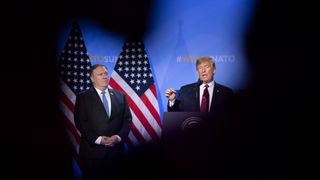Europe is starting to do what the United States has long wanted. It’s just not doing it the way the United States wants.
Following decades of US military presence in Europe, US tolerance of overseas military engagements is being questioned more than ever. The need for a stronger European pillar in the NATO alliance – to burden share the costs of European security – has been promoted by the US government for over a decade. President George W. Bush urgedgreater European military investment, President Obama complained of European free-riding, and President Trump has long called its NATO allies “delinquent”.
The European Union’s recently established Permanent Structured Cooperation on Security and Defence (PESCO) is a crucial step in facilitating development of Europe’s military capabilities in line with US demands. Signed on December 11, 2017 by 25 of the 28 EU member states, PESCO would deepen integration of the EU’s security and defence policies, enhance European military coordination and allocate European defence spending more effectively. Seventeen shared capability projects have been adopted within the PESCO framework, ranging from the establishment of a medical command centre to the Schengen-inspired unhindered provision of free movement for military units throughout the EU. PESCO would ultimately strengthen the EU’s role in the domain of international security.
Yet despite all this, the new agreement has caused turmoil in Washington DC amid unease over a potential breakdown of the US-EU military partnership.
There are two major US concerns with PESCO. Firstly, as articulated by US ambassador to NATO Kay Bailey Hutchison, PESCO could develop into a “protectionist vehicle” by cutting off American military sales in Europe, which “could splinter the strong security alliance” between the European Union and the United States. This is the result of conjectures that PESCO is a European tool for the development of its own defence products. The second, and perhaps greater US concern is the potential for strategic ties between an autonomous European Union and Russia to strengthen. EU officials have claimed that PESCO does not serve as an alternative to NATO, yet in August 2018, President of France Emmanuel Macron remarkably called for more integration of European armed forces as a substitute of reliance on the United States and the need to enter a “strategic relationship” with Russia.
Despite the theoretical possibility of a more independent Europe, significant hurdles must be overcome to turn this vision into reality. Indeed, a long history of communism in Central and Eastern Europe has generated scepticism about a tighter partnership with Russia. In fact, in August 2018, the Polish government offered the United States up to US$2 billion in exchange for the permanent deployment of American troops on its soil to safeguard the state against Russia. A weakening reliance on the United States and more Russian involvement in European security and defence issues will presumably face strong opposition in other Central and Eastern European states too.
Ultimately, PESCO does not seem to provide a short-term solution to Europe’s enduring lack of available troops and military equipment. Research suggests it would take at least a decade of disproportionally large investments to offset American military contributions through the collective development of European weapon systems. Between now and 2020 1,500 American soldiers will be added to the existing 33,000 US troops in Germany, which is one of the indicators that European cooperation with the United States remains too substantial to relinquish.
While PESCO may serve as the precursor of a long-term development towards more European independence, it ultimately has the potential to accomplish that which the US government has long sought. Nonetheless, Europe would first need to overcome significant hurdles in the years to come to ensure that a possible divorce with the United States does not undermine its own well-being.





